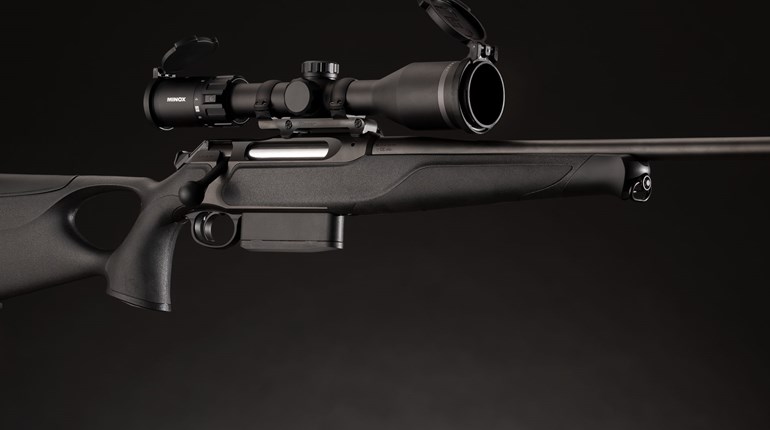
I’ve always been skeptical about the “tactical” appellation, particularly when it comes to products that, frankly, are nothing more than the same product once considered not-tactical, but now somehow is tactical because it is black, flat dark earth or covered in rails or texturing of an aggressive nature. For example, what makes a binocular tactical?
You might be asking the same question. You might also ask: “Why does this idiot call it ‘a binocular’ instead of ‘binoculars’ like a normal person?” I’ll answer the second question first, because it irks me. The word “binocular” implies the plural. After all, a single ocular is a “monocular.” Therefore, the optic you’re thinking about—one that contains two ocular lenses (or eyepieces)—is a binocular. If you call it “binoculars” or “a pair of binoculars,” that means you have more than one unit around your neck, and that’s just silly. None of this is meant to imply that I am not a pedantic jerk, but still.
On to the more important question: how can a binocular be tactical? Well, Steiner Optics has been making such binoculars in Germany and marketing them as tactical around the world for decades. Apart from a rugged appearance, I never quite understood what made a binocular tactical versus just being a useful observation tool like every other binocular on the market. I decided to find out, as the question had been vexing me.
The Steiner T856r is, unsurprisingly an 8x56 mm binocular, but that’s where the unsurprisingness ends. Despite being a large-objective, Porro-prism design, the unit is remarkably lightweight for its size. It is also ergonomically designed, making it easy to hold and view through for extended periods. The glass is exceptionally clear and, thanks both to advanced multicoating and its large objective/low magnification, it provides a very bright image. Even in low light, the T856r performed extremely well.
One thing you’ll notice immediately is the lack of a focus knob. Steiner calls the focus system Sports-Auto Focus. What that means is you set the focus for each eyepiece using a diopter—normally found on a single eyepiece for center-focus binoculars—located beneath the extended (or “Ergonomic”) eyecups, then you are good to go. The optical system automatically focuses from that point on from ranges of 20 yards and beyond. Steiner advises focusing at around 200 yards, but I was able to focus at around 50 yards and still get the full benefit of this very handy system. It’s really quite remarkable to not have to constantly change your focus while looking at objects at varying distances, and this is a huge plus in many situations, particularly dynamic ones where the tactical adjective might make sense.
Another decidedly tactical feature of the T856r is the presence in the right eyepiece of a reticle—specifically Steiner’s SUMR (Steiner Universal Milling Reticle). This reticle serves two functions, both of which are markedly useful. First, it can be used to determine the range of an object of known size, much like a mil-dot reticle in a riflescope. Each hashmark in the thin crosshair of the SUMR represents 1 mil of elevation, windage or size, and markings for 10, 20, 30, 40 and 50 mils begin in the thick posts surrounding the crosshair portion.
Second, that reticle can be extremely useful for spotting with a shooting partner. Figuring out bullet impact and directing either hold or dial adjustments for a shooter using a mil-based scope on his or her rifle is a cinch with the SUMR. The relatively low magnification of the T856r is, counterintuitively, also helpful in this regard, since it is far easier to hold an 8X binocular steady than to do so with a higher magnification unit. While you may not be able to see holes in paper at 1,000 yards, you can certainly spot impact on steel or misses around the target at long ranges. No, it’s not a spotting scope, but the T856r is also a lot more portable and doesn’t require a tripod or other mount. Plus, your depth of field is better because you are viewing through both eyes—another tactical advantage.
Rounding out the useful—if not super tactical—features of this outstanding optic are objective-lens covers and a strap that attach via Steiner’s ClicLoc system. Rather than relying on a rubber or plastic ring for the lens covers or a thread-through eyelet for the neoprene strap, Steiner’s ingenious system allows you to snap them into place via a buckle that fits into receptacles built into the binocular’s frame. It is easy, reliable and a welcome innovation.
While the T856r is an expensive binocular, it is well worth the money for long-range shooters looking to lighten the load. For tactical purposes, it is rugged, waterproof, shockproof and loaded with features that make it ideal for observation from a fixed post, yet lightweight enough to be carried on patrol. Whether you’re in uniform or just watching your property line (and beyond), Steiner has come up with a near-perfect tool for the task.
Specifications
Manufacturer: Steiner; (888) 550-6255, steiner-optics.com
Magnification: 8X
Objective Lens Diameter: 56 mm
Field-of-View: 441 feet at 1,000 yards
Height: 8.3 inches
Width: 8.3 inches
Weight: 38.9 ounces
Accessories: Neoprene neck strap, objective lens covers, rain guard, soft carry case, manual
MSRP: $1,248.99





































